Grevilleas are a favourite in gardens across Australia, and it’s easy to see why. This unfussy native shrub comes in a wide range of colours and sizes, and can flower non-stop through the cooler months, with some varieties flowering year-round.
Here are some insights on how to plant, grow and care for these indigenous beauties, as well as trouble-shooting advice on common problems these plants can experience.
More...
What are Grevilleas?
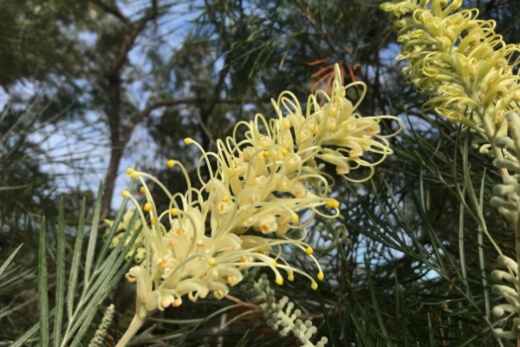
Named after Charles Francis Greville, Grevilleas are part of the Proteaceae family and are native to Australia. There are over 350 species and even more cultivars on the market, with flowers ranging from cream and yellow to pink, orange, red and lilac.
Grevilleas are all about variety, so there’s a type for almost every garden. In addition to ground covers and small shrubs, there are great screening varieties, trees and even weeping standards.
Popular Grevillea Varieties
With over 350 species and new cultivars, it’s impossible to cover every type of Grevillea! But if you’re just starting to consider these beautiful plants, here are some of the most successful and rewarding types to grow.
Grevillea ‘Seaspray’
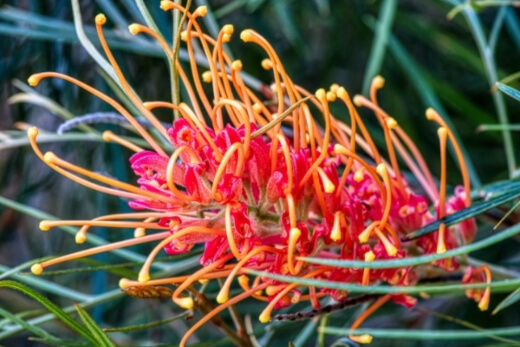
With grey foliage and rich, raspberry flowers in tight clusters, this variety is vibrant and eye-catching. Also known as Sea Spray, it grows well in sandy or limestone soils, growing to a height of about 1m and flowering from autumn to spring.
Grevillea ‘Seaspray’ growing guide
Grevillea Green Carpet (Grevillea crithmifolia)
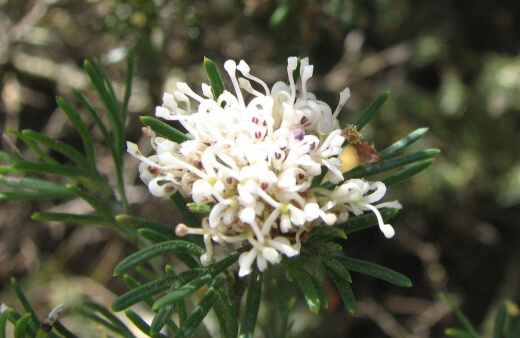
Source: commons.wikimedia.org
This soft and pretty ground cover is a spreading shrub that can reach a height of up to 1m. It produces clusters of white flowers from winter to spring that have a beautiful scent.
Grevillea crithmifolia growing guide
Grevillea Ground Cover (Grevillea nudiflora)
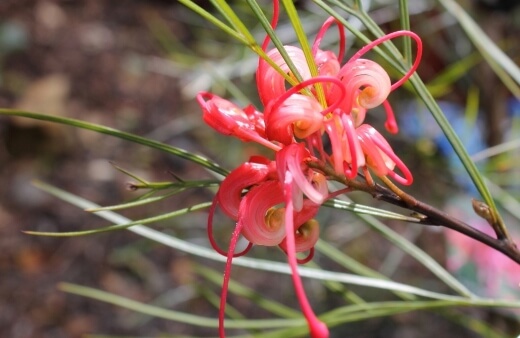
With green leaves and red flowers, this basic variety of Grevillea is a hardy, low-growing ground cover that thrives in almost any conditions, growing well in frosty areas and flowering through the spring.


Get Your Free Guide:
Master Growing Australian Natives eBook
A Must Have Complete Guide for Every Australian Garden
Get Your Free Guide:
Master Growing Australian Natives eBook
A Must Have Complete Guide for Every Australian Garden
Grevillea nudiflora growing guide
Flame Grevillea (Grevillea excelsior)
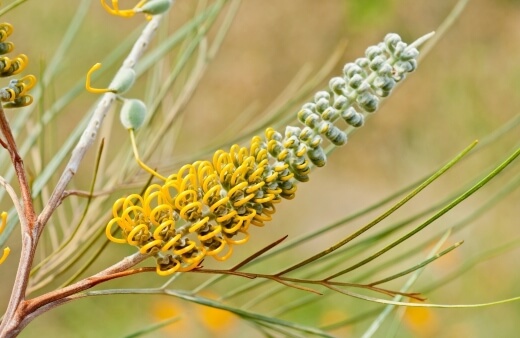
This is a large shrub that can reach up to 3-4m in height, with green foliage and flame-orange flowers that bloom in winter through spring.
It makes a fantastic feature plant for a garden, bringing in plenty of birds, butterflies and beneficial insects.
Grevillea excelsior growing guide
Grevillea ‘Honey Gem’ (Grevillea banksii x pteridifolia)

This is a hybrid mix of Grevillea banksii and Grevillea pteridifolia, creating a semi-tropical shrub that grows to about 3-5m in height and produces golden yellow flowers for most of the year.
It’s a favourite with birds and butterflies, and tends to grow tall rather than wide with pruning.
Grevillea ‘Honey Gem’ growing guide
Rosemary Grevillea (Grevillea rosmarinifolia)

This is a smaller Grevillea that’s well-suited to growing in patio containers and pots. With pink/white flowers and pointed, silvery green foliage, it resembles the rosemary plant after which it is named. It can reach up to 1.5m in height, and is also widely used as a hedge plant.
Grevilea rosmarinifolia growing guide
Grevillea ‘Moonlight’
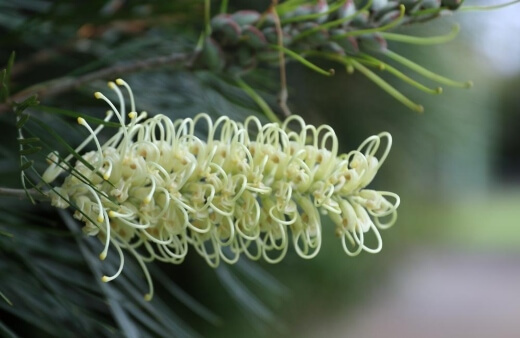
This is a robust shrub with evergreen, feathery foliage. It produces a beautiful array of ivory coloured flowers which bloom throughout the summer and long into autumn.
Grevillea ‘Robyn Gordon’

The Grevillea ‘Robyn Gordon’ is a very popular cultivar due to its compact growth habit. It is favoured for its all-year flowering habit and no-fuss growth. It’s suitable for a range of soils and climates.
Grevillea ‘Robyn Gordon’ growing guide
Grevillea ‘Superb’

As the name suggests, the Grevillea ‘Superb’ is hybrid species of the G. Banksii and G. Bipinnatifida cultivars, with long-lasting flowers which bloom in a variety of colours including coral, pink and yellow.
It prefers acidic soils and full-sun spots, but it's incredibly hardy so won’t offer growers too much hassle once established.
Grevillea ‘Superb’ growing guide
Grevillea ‘Bronze Rambler’
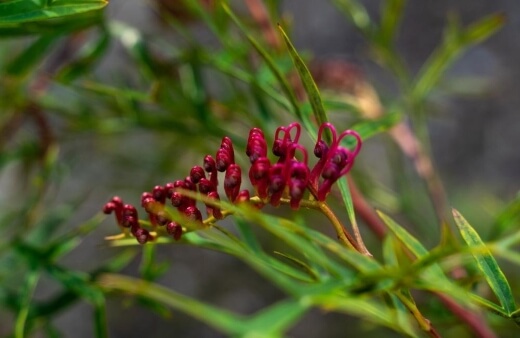
Grevillea ‘Bronze Rambler’ is an unusually prostrate grevillea, with a low-growing habit that can easily spread to cover large swathes of borders in a few short years. It's simple red stems pop out from chalky-green leaves with decorative and deeply lobed foliage.
While they flower throughout the year, their dramatic clusters of red flowers, tipped with vivid yellow pollen, are most noticeable in winter and spring.
Grevillea ‘Bronze Rambler’ growing guide
Grevillea ‘Ned Kelly’

Also referred to as the Mason’s hybrid, the ‘Ned Kelly’ cultivar offers subtle grey foliage with brilliant orange blooms which create a wonderful contrast for gardens. It’s best suited as a feature shrub or screening plant.
Grevillea ‘Ned Kelly’ growing guide
Prickly Spider Flower (Grevillea juniperina)

Grevillea juniperina is one of the most readily hybridised Grevilleas there is, but in its natural form, it’s more beautiful than most thanks to its gorgeous fuchsia coloured blooms, which pack a beautiful scent.
Various cultivars have varying flower colour, but the tight, needle-like foliage works beautifully in hedges, or as a standalone shrub regardless.
Grevillea juniperina growing guide
Grevillea ‘Peaches and Cream’
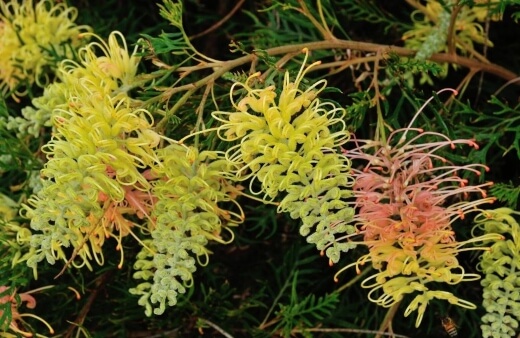
Has a unique flowering habit and small narrow leaves which create a lovely texture year-round.
Grevillea ‘Peaches and Cream’ growing guide
Grevillea ‘Ivanhoe’

Source: Gardening With Angus
Grevillea ‘Ivanhoe’ is a hybrid of the G. longifolia and G. caleyi species with exciting and interesting toothed leaves – not often found on other grevillea species.
It is prized as an attractive garden plant and best suited as hedging, screening or as a windbreak.
Grevillea ‘Ivanhoe’ growing guide
Weeping Grevillea
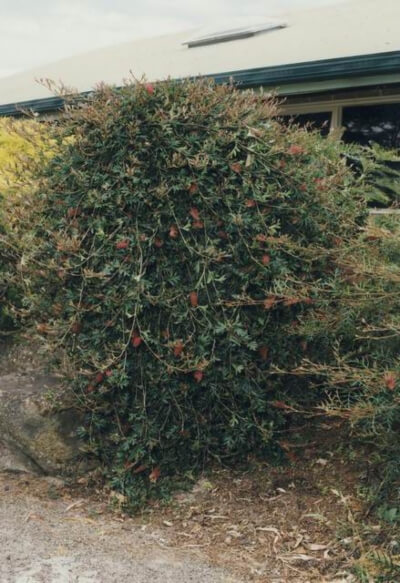
Source: Weeping Grevillea Nursery
This sun-loving variety is perfect for smaller gardens or as a feature plant. Although it’s a smaller tree it has a curious cascading growth habit, which creates an almost umbrella-like feature.
Its blooms come in a variety of colours and have a non-invasive root system – perfect for pots or compact gardens.
Olive Grevillea (Grevillea olivacea)
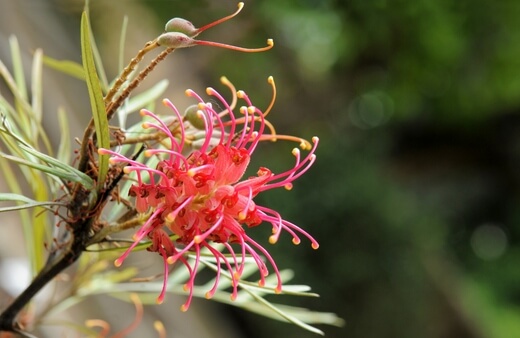
This blooming shrub produces flowers in winter and spring in shades of red, yellow and orange. The leaves are an olive green colour.
Grevillea olivacea likes a sunny spot and works well in the garden as a hedge or screen. It can grow up to a height of 4 metres.
Brown Silky Oak (Grevillea baileyana)
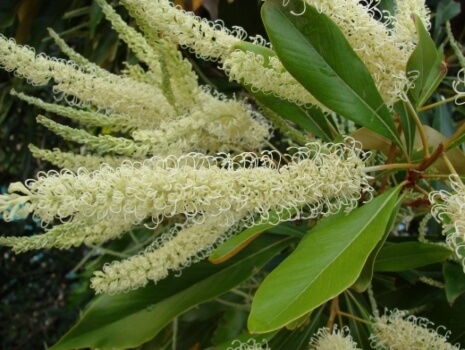
Source: Wikipedia
The brown silky oak, Grevillea baileyana, is a tree-form of Grevilleas, which starts out as a dense shrub but develops upwards with a neatly domed canopy and soft cream-coloured flowers.
While it might not be the garish statement that most Grevilleas promise, this faded giant is perfect for wildlife, and helpful to anyone trying to plant up a calmer space.
Grevillea baileyana growing guide
Grevillea ‘Loopy Lou’
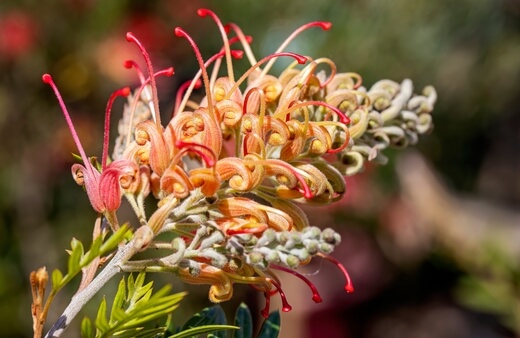
This small Grevillea produces lovely flowers all year round in shades of yellow, pink, green and orange. Growing to a height and spread of 1.5 metres, it works just as well in the garden as it does in a container.
Grevillea ‘Loopy Lou’ growing guide
Grevillea ‘Royal Mantle’

Source: Shambhala Nursery
A low maintenance ground cover that has a generous spread of up to 6 metres and produces wine-red flowers and new leaf growth in a bronze shade. This Grevillea is fast growing and flat, working great on slopes and to help with erosion control.
Grevillea ‘Royal Mantle’ growing guide
Grevillea ‘Coconut Ice’
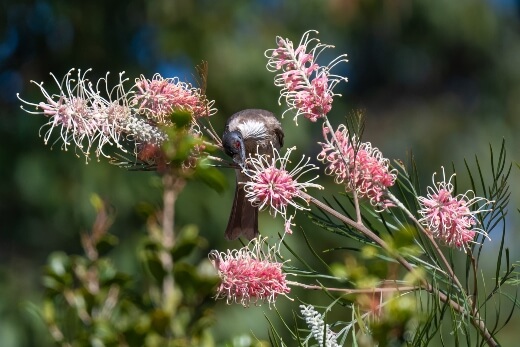
Source: Native Plant Project
Grevillea ‘Coconut Ice’ is a medium sized shrub and popular cultivar producing cream and pinkish flowers most of the year. It is much loved by local bird life, and can grow to a height and spread of up to 2 metres. Grevillea ‘Coconut Ice’ will flower best in full sun, and requires well-draining soil.
Grevillea ‘Coconut Ice’ growing guide
Red Silky Oak (Grevillea banksii)
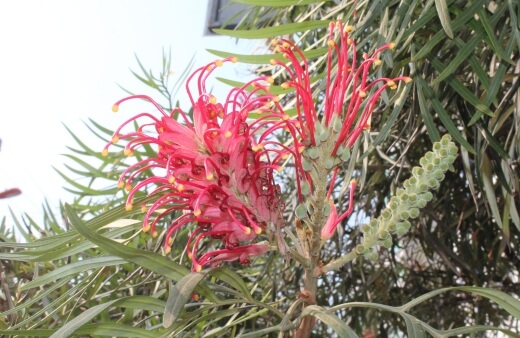
Grevillea banksii is a well-known species of Grevillea and is often selected as one of the parent plants to create new Grevillea hybrids. It is known either as a large shrub or small tree, reaching a height of up to 8 metres and a spread of 3 metres.
The leaves are a green to silver colour and it produces large and beautiful flowers that are shades of red or pink, depending on the variety.
Grevillea banksii growing guide
Grevillea magnifica
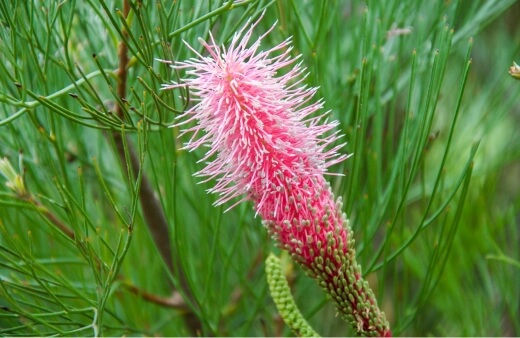
This is a unique Grevillea that grows up to 4 metres tall and 2 metres wide. It features clusters of iridescent pink flower spikes that bloom from late winter to spring.
It needs well-drained soil to thrive but is generally a low-maintenance addition to the garden. It will make for excellent colourful shrubbery outdoors and can even be grown in patio container gardens.
Grevillea magnifica growing guide
Grevillea lanigera
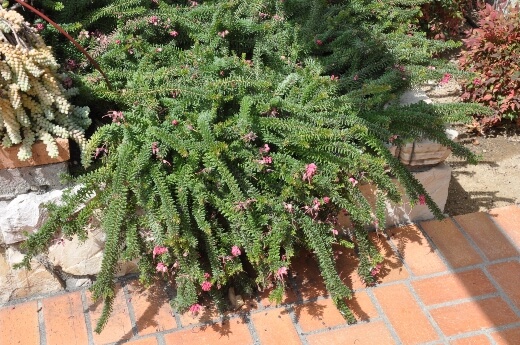
Source: PlantMaster
This prized prostrate Grevillea features hot pink blooms, lush woolly foliage and a wonderfully spreading habit, perfect for use as an attractive groundcover or in mass plantings.
It only reaches a maximum height of around 1.5 metres tall and prefers sunny positions in sandy to medium loam soil when cultivated in gardens.
Grevillea lanigera growing guide
Grevillea sericea
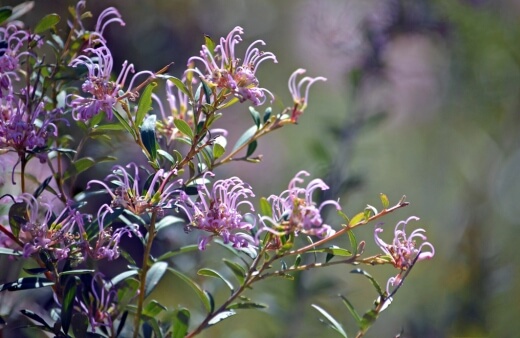
Boasting massive clusters of pink spidery flowers throughout most of the year, it's easy to see why this Grevillea species is so adored.
Amidst the nectar-rich blooms, you’ll find light green lance-shaped leaves that just add to this plant's already impressive characteristics.
Be sure to plant in well-drained soils and position in a sunny spot and you’ll have a stunner of a shrub to elevate your garden. Growth is around 1 to 2 metres tall and wide.
Grevillea sericea growing guide
Grevillea ‘Orange Marmalade’
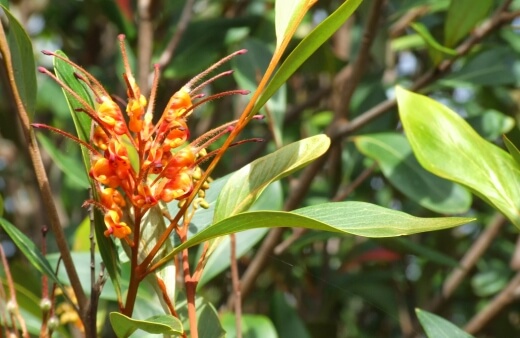
Grevillea ‘Orange Marmalade’ is a gorgeous cultivar, and while it’s not technically native to Australia, its parents are G. glossadenia and G. venusta which are perfectly suited for use as hedging plants.
With regular pruning, it can form a dense shrub, or be left to grow leggy for a lighter structure, but personally I much prefer pruning it, like most short Grevilleas back by about a third each year so it forms a denser, and stronger shape.
Grevillea ‘Orange Marmalade’ growing guide
Pink Pokers (Grevillea petrophiloides)
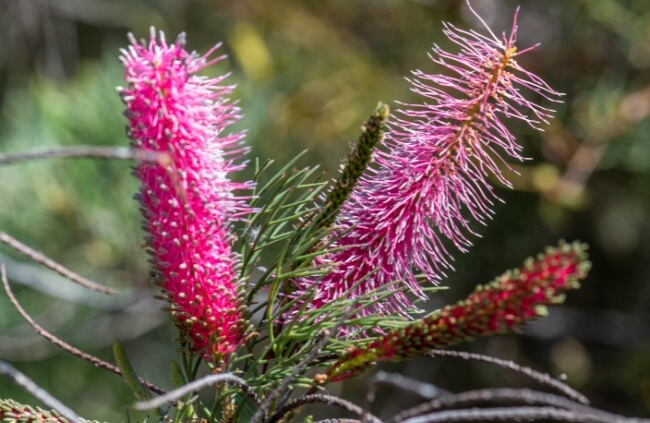
Known commonly as the Rock Grevillea or Pink Pokers, this bottle-brush-like Grevillea is a stunning addition to any garden.
It reaches about 3 m tall, but nearly always retains a frothy, shrubby shape, meaning you can use it easily as a privacy hedge, or just as a reliable windbreak.
Obviously, there’s a huge bonus too is the uniquely long pink flowers too, which turn this otherwise inconspicuous shrub into something truly spectacular.
Deua Grevillea (Grevillea rhyolitica)
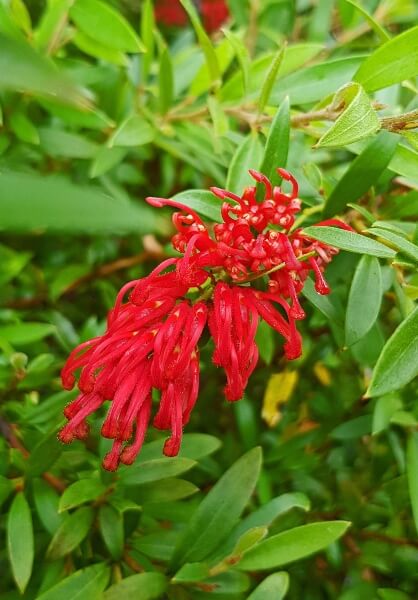
Source: Macquarie University
Deua Grevillea is a common garden shrub, with wide leaves making for a gentler overall look. Its drooping red flowers have a dusty charm, and it reaches a mature height of 2 m in around eight years so is a great way to make your garden look mature if you’re short on patience.
With wider foliage, it ripples beautifully in the wind and has a far gentler appearance than most Grevilleas, working well with non-natives and natives alike – I think it looks great with the blousy blooms of mop head hydrangeas.
Grevillea rhyolitica growing guide
Silky Oak Tree (Grevillea robusta)

Typically growing to about 20 m tall, the Silky Oak is one of our most iconic native trees. Their pinnate leaves pair perfectly with their textured bark, and glowing amber flowers light up gardens and parks in late winter.
The sap is an irritant and can be toxic, so handle these plants with care. If you notice excessive sap, it’s likely responding to environmental conditions, but it’s perfectly healthy.
Grevillea robusta growing guide
Spider Net Grevillea (Grevillea thelemanniana)
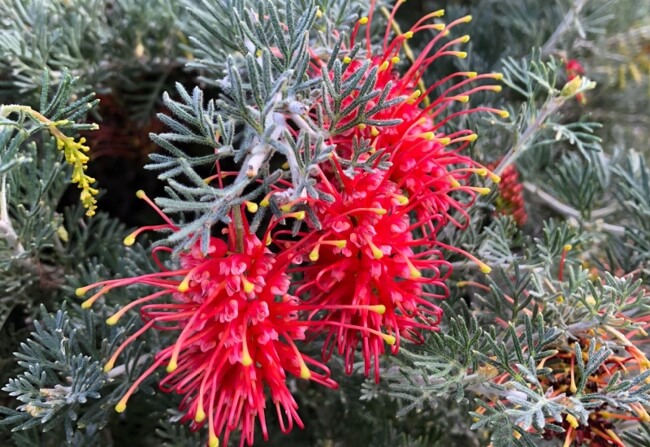
Source: Austraflora
There are quite a few different hybrids and cultivars of Grevillea thelemanniana, but the prostrate form is probably the most useful.
Its blue-green foliage is incredibly conifer-like, so makes a great low-maintenance alternative to dwarf conifers in ornamental gardens.
It’s drooping, spidery, flowers are great for wildlife, and last for weeks
Grevillea thelemanniana growing guide
Grevillea ‘Mt Tamboritha’
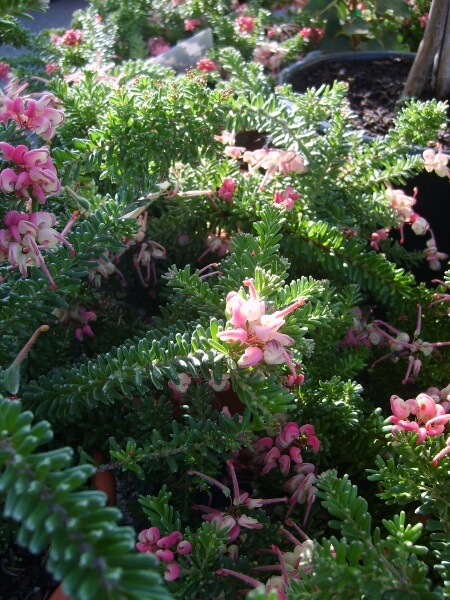
Source: Wikipedia
My favourite dwarf Grevillea is ‘Mt Tamboritha’. Its succulent leaves are fascinatingly unusual, and its dainty plump blooms are beautifully charming.
Planted in rockeries, gravel gardens or raised beds, it will add something different to your garden, and requires very little care once established.
Johnson’s Spider Flower (Grevillea johnsonii)
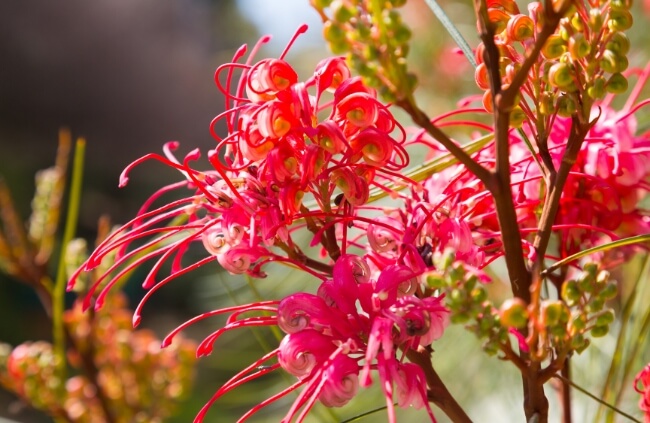
Johnson’s spider flower, Grevillea johnsonii, is a particularly delicate Grevillea species. Its fine needle-shaped leaves allow light to pass through, but filter wind into the garden, while its densely curled flowers feature slender hairs that poke right out from the centre which perfectly match the foliage.
Grevillea johnsonii is great for dry gardens, but will need regular watering while it establishes.
Royal Grevillea (Grevillea victoriae)
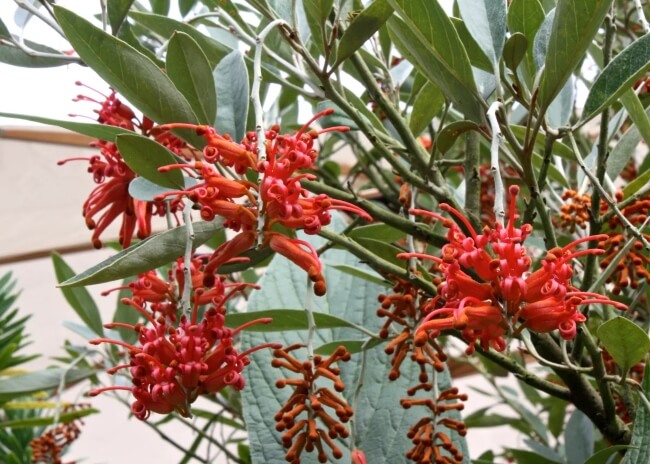
Source: The Frustrated Gardener
There are a few more varied cultivars of Grevillea victoriae, some with beautifully tinted flowers, but in its raw form, it’s a bold statement shrub, with tall arching stems and pale bark that shows off the silvery foliage perfectly.
If you’ve got a gravelly garden, or any plot with rapid drainage, this Grevillea would be a wonderful solution that offers height and structure, but is easily controllable with surprisingly harsh pruning.
Lavender Grevillea (Grevillea lavandulacea)
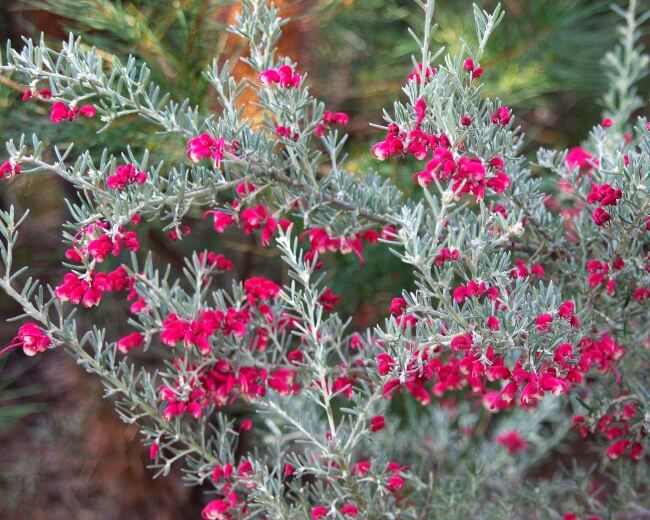
Source: GardensOnline
If you’ve ever struggled to grow lavender, this aptly named Grevillea is worth a try. It grows in similar conditions, but copes better with Australian seasons, and in spring boasts gorgeous silvery foliage tipped with plentiful pinky-red blooms.
It’s a prostrate Grevillea, so stays fairly low to the ground and can be used to trail over walls and rockeries as well as a simple ground cover Grevillea.
Fuchsia Grevillea (Grevillea bipinnatifida)
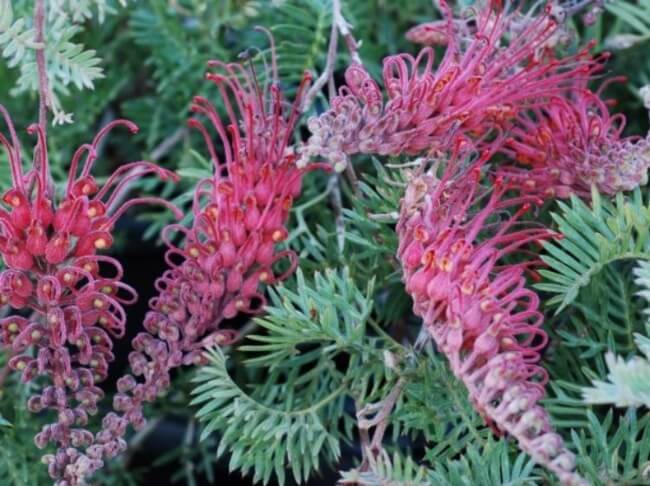
Source: Plantmark
There are two common names for Grevillea bipinnatifida; fuchsia grevillea and grape grevillea.
While it’s more commonly known as the Fuchsia Grevillea, it’s the drooping blooms that hang like grapes that have me religiously stuck to calling it the grape grevillea.
Where it does resemble fuchsias most though, is in how easy it is to prune and train as a standard.
In theory, Grevillea bipinnatifida is a spreading, fairly low growing shrub, but with a bit of trickery you can train it up with supports to form a neat dome of foliage and flowers in a lollipop shape that offers stunning hanging foliage.
Red Spider Flower (Grevillea speciosa)

Source: Australian Plants Society
Grevillea speciosa is a great structural shrub, growing to a maximum of about 2 m tall, but typically lower.
Its upright foliage is unusual and through summer looks more like an olive tree than anything else, making it easy to get that true Mediterranean feel at home. Its bright crimson red flowers lend themselves to its common name, the red spider flower.
Sand Grevillea (Grevillea arenaria)
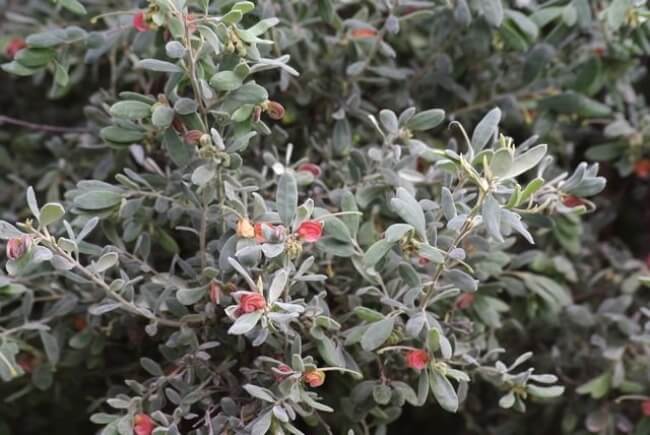
Source: Wildtech Plants
The Sand Grevlliea has subtle flowers, so isn’t one for showy gardens. If you’re after a bristling beach vibe in the garden though, there are few more appropriate plants than Grevillea arenaria.
Its ovate leaves are sparse and silvery, with flowers on growing tips over a long season. Tight pruning is an option, but it looks its best when pruned back to nodes to retain a more natural shape.
Linear leaf Grevillea (Grevillea linearifolia)

Source: Trigg Plants
One of the most elegant grevilleas to grow at home is the native Grevillea linearifolia (the linear leaf grevillea). It’s native to NSW and tolerates light shade.
Provided there’s reasonable drainage, it will grow in most conditions, presenting a sparse but eye-catching display of small, white, spider flowers to accompany the long willowy foliage.
Grey Spider Flower (Grevillea buxifolia)

Called buxifolia after buxus, the tight-leaved shrub most commonly used for formal hedging around the world, this tidy grevillea is perfect for hedging.
Thanks to its dense, miniature foliage, and plentiful honeysuckle-like flowers, there are few Grevilleas better adapted to hedging than Grevillea buxifolia.
Grevillea candelabroides
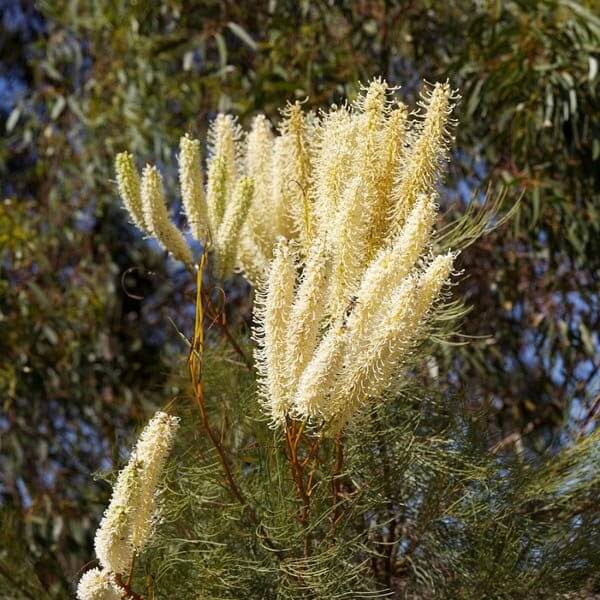
Source: Australian Seed
If you want dramatic blooms, Grevillea candelabroides has them in buckets. The tall, dense, vanilla coloured and scented flowers bloom in stages, meaning you can benefit from their impactful structure for several weeks, even months if you’re lucky.
The slender foliage is so fine that it’s easy to mistake for grasses, but if you’re truly after drama, Grevillea candelabroides has to be the plant for you.
Obtuse Leaved Grevillea (Grevillea obtusifolia)

Source: Flower Power
One low-maintenance and quick-spreading ground cover grevillea is Grevillea obtusifolia (the obtuse leaved grevillea).
Spreading into dense mounds a single plant can cover an entire border with time, and unlike many ground cover grevilleas, flowers are just as dramatic as shrub forms.
Grevillea obtusifolia ‘Gin Gin Gem’ is a most famous cultivar and reliable in most gardens.
Gully Grevillea (Grevillea barklyana)
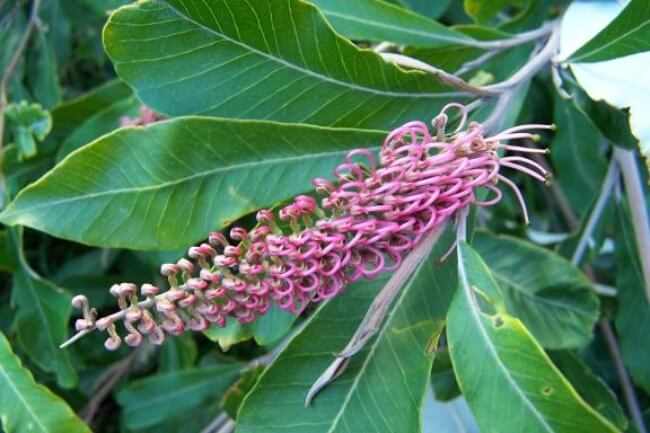
Source: Redbreast Plants
The hue leaves and unusually one-sided flowers of Grevillea barklyana are unmistakable. The deeply serrated leaves are stunning in themselves, with deeply cut pointed lobes along smooth red stems.
The flowers bloom upwards and in sequence, and in full sun with good drainage, it often displays a wispy silver tone in winter and spring.
Grevillea barklyana can be grown as a shrub or small tree depending on how you prune it (or don’t) but looks just as good either way.
Personally, I prefer it pruned quite small so you get more of a view of the foliage and blooms.
McCutcheon's Grevillea (Grevillea maccutcheonii)
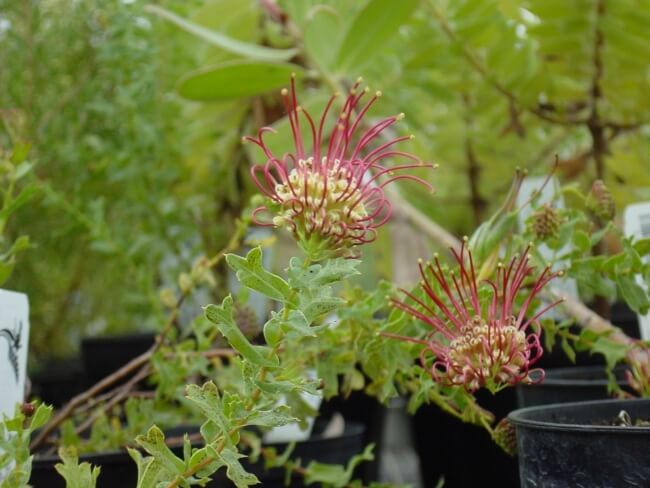
Source: The National Botanic Garden of Wales
McCutcheon's grevillea grows in a tight pocket near Busselton, south of Perth. It’s endangered in the wild, so you’re unlikely to find one in a garden centre any time soon, and it’s illegal to harvest flowers, seeds, or any part of the plant in the wild.
However, if you ever come across this wiry-flowered species, with its deeply loved leaves that look like elongated ivy, it’s worth stopping and appreciating its natural adaptations and taking in its fragrance.
Grampians Grevillea (Grevillea confertifolia)
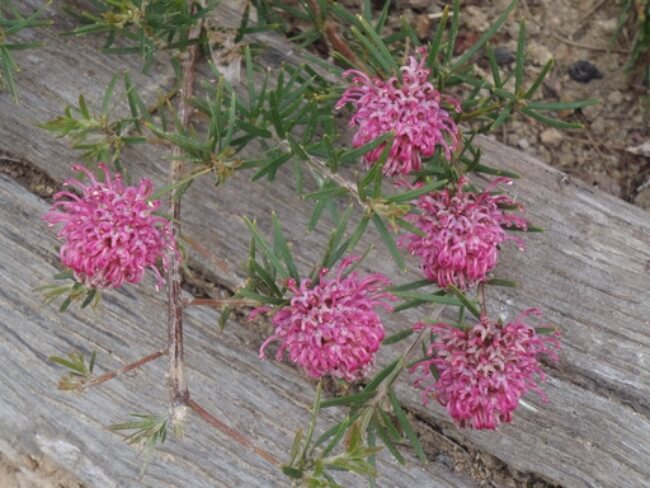
Source: ANPS labels
Dense leaf grevillea offers plenty of options to gardeners, particularly its prostrate form, which works beautifully as a loose and informal ground cover.
The tight flowers take centre stage every year before the silvery pinnate leaves become the star attraction of Grevillea confertifolia.
Sandstone Grevillea (Grevillea miniata)
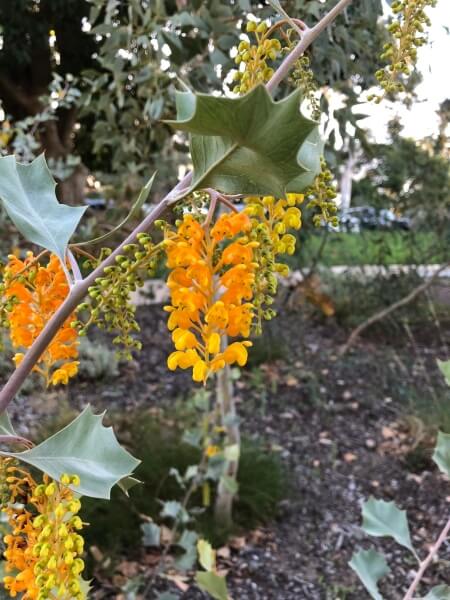
Source: iNaturalist
Sandstone grevillea has head-turning yellow flowers, with such vigour that they are just impossible to miss. Its silvery foliage is sparse but each leaf is substantial by itself, creating a beautiful backdrop to the drooping blooms.
It’s nearly always found as a tree thanks to its tall upright habit but can be pruned as a shrub.
Grevillea candicans

With its bold white flowers and dense, dark, green foliage, Grevillea candicans is one of the plainest grevilleas in the world, and sits beautifully in the landscape without taking over.
The bushy shrub has long leaves with incredibly deep lobes, giving the effect of pinnate leaves but with a far gentler movement.
Prickly Plume Grevillea (Grevillea annulifera)

Source: iNaturalist
Also called the Prickly Plume Grevillea, Grevillea annulifera tends to flower above the rest of the plant at the ends of stems, creating a smoky plume which fades between creamy white and pale pink.
The result is one of the most beautiful species of grevillea on the plant, and one that completely defines its landscape wherever it is.
Grevillea intricata
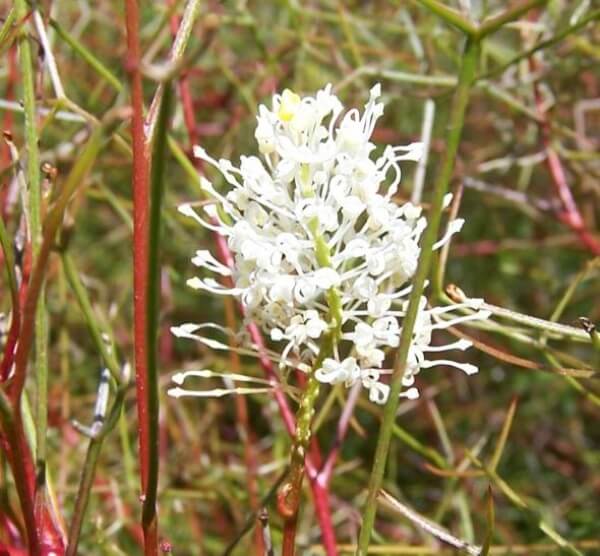
Source: Redbreast Plants
This widespread upright grevillea is easy to cultivate and thrives in full sun. Its most striking characteristic is the conical flower form, similar to more thuggish buddleia, but without the extremely invasive tendency.
Young plants tend to look better and cutting it back to about 1.5 m tall will retain a denser flowering structure, but the stippled flowers on mature plants are still gorgeous, and stand out late into the evening.
Grevillea ‘Poorinda Queen’
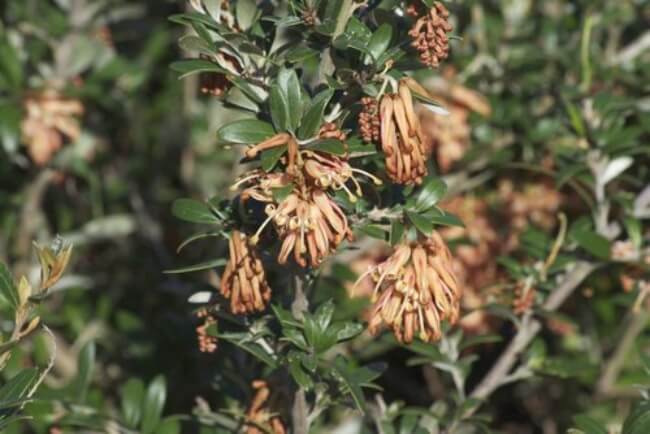
Source: Wildtech Plants
Grevillea ‘Poorinda Queen’ is one of the most popular garden cultivars, with an ultimate height of about 4 m, but a reliable shrub form regardless of maturity.
Each willowy leaf is spaced evenly along a dense stem, and accompanied by delicately apricot-coloured flowers at branch tips.
Grevillea ‘Poorinda Constance’

Source: Pan Global Plants
Poorinda grevilleas are fairly common, with several cultivars sharing the same mantle, but ‘Poorinda Constance’ is one of the most reliable, with similar leaves and structure to ‘Poorinda Queen’, but much deeper flower colour, and more even foliage colour through every season.
Cat's Claw Grevillea (Grevillea alpina)

One of the loveliest low-growing grevilleas is Grevillea alpina, which grows all over the country, and despite its name mountain grevillea, is more common on low ground than in mountains.
Even so, this wiry plant has charming features and is well worth trying to get hold of. Grevillea alpina flowers curl round neatly with red bases and yellow tips, giving them the name Cat’s Claws.
Grevillea ‘Sunset Bronze’
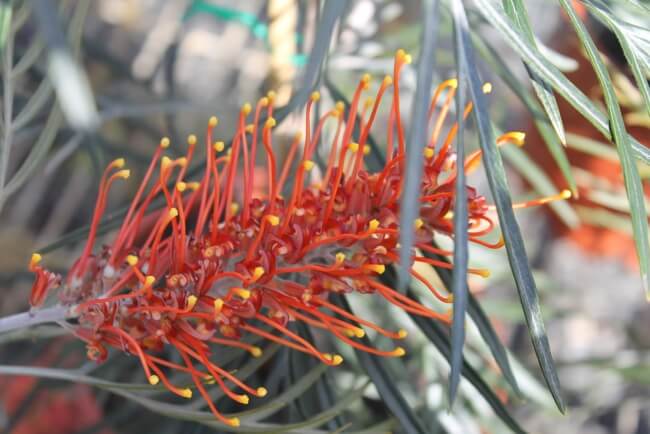
Source: Ross Evans Garden Centre
Grevillea ‘Sunset Bronze’ (Also called ‘Sunset Splendour’) is readily available in Australian garden centres, and popular amongst gardeners.
It forms neat mounds with or without pruning, with evenly spaced long red blooms, with bright yellow tips to each of the protruding stigmas.
The bristling silvery foliage is a wonderful addition to any garden border, setting off other plants perfectly even when its own flowering season has come to a close.
Grevillea ‘Dorothy Gordon’
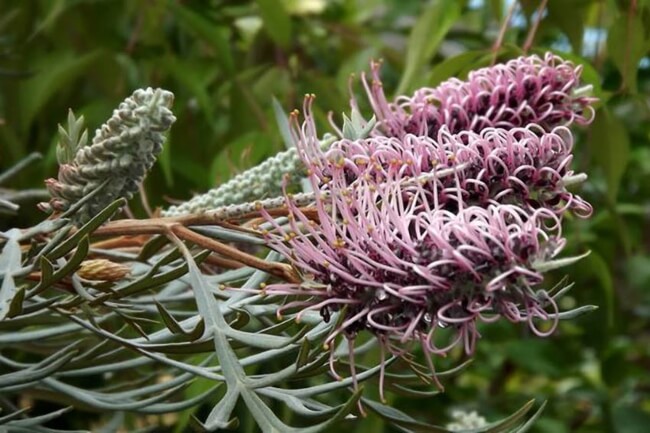
One of the most attractive Grevillea cultivars, the ‘Dorothy Gordon’ features large cone-shaped mauve-pink flowers which are borne throughout most of the year.
This compact shrub grows to a height of up to 3 metres with a width of around 2 metres.
Grevillea ‘Dorothy Gordon’ growing guide
Grevillea ‘John Evans’
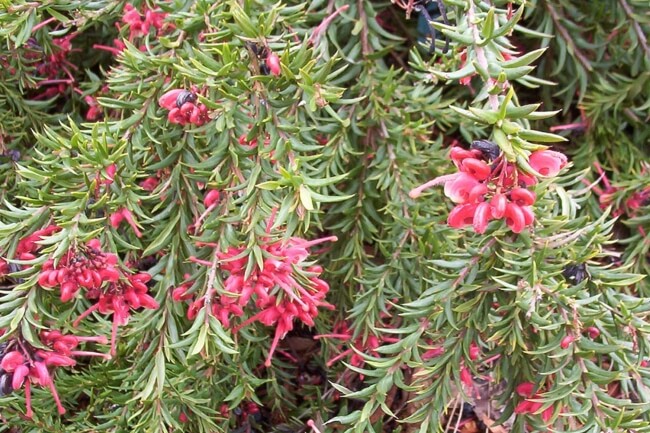
This select Grevillea cultivar grows well in the cool and temperate regions of Australia. It is a compact, medium-sized evergreen shrub up to 1.5 metres tall and wide.
Lovely pink to red spidery blooms appear from winter to spring and the shrub itself will suit many applications within gardens.
Grevillea ‘Seaspray’ With grey foliage and rich, raspberry flowers in tight clusters, this variety is vibrant and eye-catching. Also known as Sea Spray, it grows well in sandy or limestone soils, growing to a height of about 1m and flowering from autumn to spring. |  |
|---|---|
Grevillea Green Carpet (Grevillea crithmifolia) This soft and pretty ground cover is a spreading shrub that can reach a height of up to 1m. It produces clusters of white flowers from winter to spring that have a beautiful scent. |  Source: commons.wikimedia.org |
Grevillea Ground Cover (Grevillea nudiflora) With green leaves and red flowers, this basic variety of Grevillea is a hardy, low-growing ground cover that thrives in almost any conditions, growing well in frosty areas and flowering through the spring. |  |
Flame Grevillea (Grevillea excelsior) This is a large shrub that can reach up to 3-4m in height, with green foliage and flame-orange flowers that bloom in winter through spring. It makes a fantastic feature plant for a garden, bringing in plenty of birds, butterflies and beneficial insects. |  |
Grevillea ‘Honey Gem’ (Grevillea banksii x pteridifolia) This is a hybrid mix of Grevillea banksii and Grevillea pteridifolia, creating a semi-tropical shrub that grows to about 3-5m in height and produces golden yellow flowers for most of the year. It’s a favourite with birds and butterflies, and tends to grow tall rather than wide with pruning. |  |
Rosemary Grevillea (Grevillea rosmarinifolia) This is a smaller Grevillea that’s well-suited to growing in patio containers and pots. With pink/white flowers and pointed, silvery green foliage, it resembles the rosemary plant after which it is named. It can reach up to 1.5m in height, and is also widely used as a hedge plant. |  |
Grevillea ‘Moonlight’ This is a robust shrub with evergreen, feathery foliage. It produces a beautiful array of ivory coloured flowers which bloom throughout the summer and long into autumn. |  |
Grevillea ‘Robyn Gordon’ The Grevillea ‘Robyn Gordon’ is a very popular cultivar due to its compact growth habit. It is favoured for its all-year flowering habit and no-fuss growth. It’s suitable for a range of soils and climates. |  |
Grevillea ‘Superb’ As the name suggests, the Grevillea ‘Superb’ is hybrid species of the G. Banksii and G. Bipinnatifida cultivars, with long-lasting flowers which bloom in a variety of colours including coral, pink and yellow. It prefers acidic soils and full-sun spots, but it's incredibly hardy so won’t offer growers too much hassle once established. |  |
Grevillea ‘Bronze Rambler’ Grevillea ‘Bronze Rambler’ is an unusually prostrate grevillea, with a low-growing habit that can easily spread to cover large swathes of borders in a few short years. It's simple red stems pop out from chalky-green leaves with decorative and deeply lobed foliage. While they flower throughout the year, their dramatic clusters of red flowers, tipped with vivid yellow pollen, are most noticeable in winter and spring. |  |
Grevillea ‘Ned Kelly’ Also referred to as the Mason’s hybrid, the ‘Ned Kelly’ cultivar offers subtle grey foliage with brilliant orange blooms which create a wonderful contrast for gardens. It’s best suited as a feature shrub or screening plant. |  |
Prickly Spider Flower (Grevillea juniperina) Grevillea juniperina is one of the most readily hybridised Grevilleas there is, but in its natural form, it’s more beautiful than most thanks to its gorgeous fuchsia coloured blooms, which pack a beautiful scent. Various cultivars have varying flower colour, but the tight, needle-like foliage works beautifully in hedges, or as a standalone shrub regardless. |  |
Grevillea ‘Peaches and Cream’ Has a unique flowering habit and small narrow leaves which create a lovely texture year-round. |  |
Grevillea ‘Ivanhoe’ Grevillea ‘Ivanhoe’ is a hybrid of the G. longifolia and G. caleyi species with exciting and interesting toothed leaves – not often found on other grevillea species. It is prized as an attractive garden plant and best suited as hedging, screening or as a windbreak. |  Source: Gardening With Angus |
Weeping Grevillea This sun-loving variety is perfect for smaller gardens or as a feature plant. Although it’s a smaller tree it has a curious cascading growth habit, which creates an almost umbrella-like feature. Its blooms come in a variety of colours and have a non-invasive root system – perfect for pots or compact gardens. |  Source: Weeping Grevillea Nursery |
Olive Grevillea (Grevillea olivacea) This blooming shrub produces flowers in winter and spring in shades of red, yellow and orange. The leaves are an olive green colour. Grevillea olivacea likes a sunny spot and works well in the garden as a hedge or screen. It can grow up to a height of 4 metres. |  |
Brown Silky Oak (Grevillea baileyana) The brown silky oak, Grevillea baileyana, is a tree-form of Grevilleas, which starts out as a dense shrub but develops upwards with a neatly domed canopy and soft cream-coloured flowers. While it might not be the garish statement that most Grevilleas promise, this faded giant is perfect for wildlife, and helpful to anyone trying to plant up a calmer space. |  Source: Wikipedia |
Grevillea ‘Loopy Lou’ This small Grevillea produces lovely flowers all year round in shades of yellow, pink, green and orange. Growing to a height and spread of 1.5 metres, it works just as well in the garden as it does in a container. |  |
Grevillea ‘Royal Mantle’ A low maintenance ground cover that has a generous spread of up to 6 metres and produces wine-red flowers and new leaf growth in a bronze shade. This Grevillea is fast growing and flat, working great on slopes and to help with erosion control. |  Source: Shambhala Nursery |
Grevillea ‘Coconut Ice’ Grevillea ‘Coconut Ice’ is a medium sized shrub and popular cultivar producing cream and pinkish flowers most of the year. It is much loved by local bird life, and can grow to a height and spread of up to 2 metres. Grevillea ‘Coconut Ice’ will flower best in full sun, and requires well-draining soil. |  Source: Native Plant Project |
Red Silky Oak (Grevillea banksii) Grevillea banksii is a well-known species of Grevillea and is often selected as one of the parent plants to create new Grevillea hybrids. It is known either as a large shrub or small tree, reaching a height of up to 8 metres and a spread of 3 metres. The leaves are a green to silver colour and it produces large and beautiful flowers that are shades of red or pink, depending on the variety. |  |
Grevillea magnifica This is a unique Grevillea that grows up to 4 metres tall and 2 metres wide. It features clusters of iridescent pink flower spikes that bloom from late winter to spring. It needs well-drained soil to thrive but is generally a low-maintenance addition to the garden. It will make for excellent colourful shrubbery outdoors and can even be grown in patio container gardens. |  |
Grevillea lanigera This prized prostrate Grevillea features hot pink blooms, lush woolly foliage and a wonderfully spreading habit, perfect for use as an attractive groundcover or in mass plantings. It only reaches a maximum height of around 1.5 metres tall and prefers sunny positions in sandy to medium loam soil when cultivated in gardens. |  Source: PlantMaster |
Grevillea sericea Boasting massive clusters of pink spidery flowers throughout most of the year, it's easy to see why this Grevillea species is so adored. Amidst the nectar-rich blooms, you’ll find light green lance-shaped leaves that just add to this plant's already impressive characteristics. Be sure to plant in well-drained soils and position in a sunny spot and you’ll have a stunner of a shrub to elevate your garden. Growth is around 1 to 2 metres tall and wide. |  |
Grevillea ‘Orange Marmalade’ Grevillea ‘Orange Marmalade’ is a gorgeous cultivar, and while it’s not technically native to Australia, its parents are G. glossadenia and G. venusta which are perfectly suited for use as hedging plants. With regular pruning, it can form a dense shrub, or be left to grow leggy for a lighter structure, but personally I much prefer pruning it, like most short Grevilleas back by about a third each year so it forms a denser, and stronger shape. |  |
Pink Pokers (Grevillea petrophiloides) Known commonly as the Rock Grevillea or Pink Pokers, this bottle-brush-like Grevillea is a stunning addition to any garden. It reaches about 3 m tall, but nearly always retains a frothy, shrubby shape, meaning you can use it easily as a privacy hedge, or just as a reliable windbreak. Obviously, there’s a huge bonus too is the uniquely long pink flowers too, which turn this otherwise inconspicuous shrub into something truly spectacular. |  |
Deua Grevillea (Grevillea rhyolitica) Deua Grevillea is a common garden shrub, with wide leaves making for a gentler overall look. Its drooping red flowers have a dusty charm, and it reaches a mature height of 2 m in around eight years so is a great way to make your garden look mature if you’re short on patience. With wider foliage, it ripples beautifully in the wind and has a far gentler appearance than most Grevilleas, working well with non-natives and natives alike – I think it looks great with the blousy blooms of mop head hydrangeas. |  Source: Macquarie University |
Silky Oak Tree (Grevillea robusta) Typically growing to about 20 m tall, the Silky Oak is one of our most iconic native trees. Their pinnate leaves pair perfectly with their textured bark, and glowing amber flowers light up gardens and parks in late winter. The sap is an irritant and can be toxic, so handle these plants with care. If you notice excessive sap, it’s likely responding to environmental conditions, but it’s perfectly healthy. |  |
Spider Net Grevillea (Grevillea thelemanniana) There are quite a few different hybrids and cultivars of Grevillea thelemanniana, but the prostrate form is probably the most useful. Its blue-green foliage is incredibly conifer-like, so makes a great low-maintenance alternative to dwarf conifers in ornamental gardens. It’s drooping, spidery, flowers are great for wildlife, and last for weeks |  Source: Austraflora |
Grevillea ‘Mt Tamboritha’ My favourite dwarf Grevillea is ‘Mt Tamboritha’. Its succulent leaves are fascinatingly unusual, and its dainty plump blooms are beautifully charming. Planted in rockeries, gravel gardens or raised beds, it will add something different to your garden, and requires very little care once established. |  Source: Wikipedia |
Johnson’s Spider Flower (Grevillea johnsonii) Johnson’s spider flower, Grevillea johnsonii, is a particularly delicate Grevillea species. Its fine needle-shaped leaves allow light to pass through, but filter wind into the garden, while its densely curled flowers feature slender hairs that poke right out from the centre which perfectly match the foliage. Grevillea johnsonii is great for dry gardens, but will need regular watering while it establishes. |  |
Royal Grevillea (Grevillea victoriae) There are a few more varied cultivars of Grevillea victoriae, some with beautifully tinted flowers, but in its raw form, it’s a bold statement shrub, with tall arching stems and pale bark that shows off the silvery foliage perfectly. If you’ve got a gravelly garden, or any plot with rapid drainage, this Grevillea would be a wonderful solution that offers height and structure, but is easily controllable with surprisingly harsh pruning. |  Source: The Frustrated Gardener |
Lavender Grevillea (Grevillea lavandulacea) If you’ve ever struggled to grow lavender, this aptly named Grevillea is worth a try. It grows in similar conditions, but copes better with Australian seasons, and in spring boasts gorgeous silvery foliage tipped with plentiful pinky-red blooms. It’s a prostrate Grevillea, so stays fairly low to the ground and can be used to trail over walls and rockeries as well as a simple ground cover Grevillea. |  Source: GardensOnline |
Fuchsia Grevillea (Grevillea bipinnatifida) There are two common names for Grevillea bipinnatifida; fuchsia grevillea and grape grevillea. While it’s more commonly known as the Fuchsia Grevillea, it’s the drooping blooms that hang like grapes that have me religiously stuck to calling it the grape grevillea. Where it does resemble fuchsias most though, is in how easy it is to prune and train as a standard. In theory, Grevillea bipinnatifida is a spreading, fairly low growing shrub, but with a bit of trickery you can train it up with supports to form a neat dome of foliage and flowers in a lollipop shape that offers stunning hanging foliage. |  Source: Plantmark |
Red Spider Flower (Grevillea speciosa) Grevillea speciosa is a great structural shrub, growing to a maximum of about 2 m tall, but typically lower. Its upright foliage is unusual and through summer looks more like an olive tree than anything else, making it easy to get that true Mediterranean feel at home. Its bright crimson red flowers lend themselves to its common name, the red spider flower. |  Source: Australian Plants Society |
Sand Grevillea (Grevillea arenaria) The Sand Grevlliea has subtle flowers, so isn’t one for showy gardens. If you’re after a bristling beach vibe in the garden though, there are few more appropriate plants than Grevillea arenaria. Its ovate leaves are sparse and silvery, with flowers on growing tips over a long season. Tight pruning is an option, but it looks its best when pruned back to nodes to retain a more natural shape. |  Source: Wildtech Plants |
Linear leaf Grevillea (Grevillea linearifolia) One of the most elegant grevilleas to grow at home is the native Grevillea linearifolia (the linear leaf grevillea). It’s native to NSW and tolerates light shade. Provided there’s reasonable drainage, it will grow in most conditions, presenting a sparse but eye-catching display of small, white, spider flowers to accompany the long willowy foliage. |  Source: Trigg Plants |
Grey Spider Flower (Grevillea buxifolia) Called buxifolia after buxus, the tight-leaved shrub most commonly used for formal hedging around the world, this tidy grevillea is perfect for hedging. Thanks to its dense, miniature foliage, and plentiful honeysuckle-like flowers, there are few Grevilleas better adapted to hedging than Grevillea buxifolia. |  |
Grevillea candelabroides If you want dramatic blooms, Grevillea candelabroides has them in buckets. The tall, dense, vanilla coloured and scented flowers bloom in stages, meaning you can benefit from their impactful structure for several weeks, even months if you’re lucky. The slender foliage is so fine that it’s easy to mistake for grasses, but if you’re truly after drama, Grevillea candelabroides has to be the plant for you. |  Source: Australian Seed |
Obtuse Leaved Grevillea (Grevillea obtusifolia) One low-maintenance and quick-spreading ground cover grevillea is Grevillea obtusifolia (the obtuse leaved grevillea). Spreading into dense mounds a single plant can cover an entire border with time, and unlike many ground cover grevilleas, flowers are just as dramatic as shrub forms. Grevillea obtusifolia ‘Gin Gin Gem’ is a most famous cultivar and reliable in most gardens. |  Source: Flower Power |
Gully Grevillea (Grevillea barklyana) The hue leaves and unusually one-sided flowers of Grevillea barklyana are unmistakable. The deeply serrated leaves are stunning in themselves, with deeply cut pointed lobes along smooth red stems. The flowers bloom upwards and in sequence, and in full sun with good drainage, it often displays a wispy silver tone in winter and spring. Grevillea barklyana can be grown as a shrub or small tree depending on how you prune it (or don’t) but looks just as good either way. Personally, I prefer it pruned quite small so you get more of a view of the foliage and blooms. |  Source: Redbreast Plants |
McCutcheon's Grevillea (Grevillea maccutcheonii) McCutcheon's grevillea grows in a tight pocket near Busselton, south of Perth. It’s endangered in the wild, so you’re unlikely to find one in a garden centre any time soon, and it’s illegal to harvest flowers, seeds, or any part of the plant in the wild. However, if you ever come across this wiry-flowered species, with its deeply loved leaves that look like elongated ivy, it’s worth stopping and appreciating its natural adaptations and taking in its fragrance. | |
Grampians Grevillea (Grevillea confertifolia) Dense leaf grevillea offers plenty of options to gardeners, particularly its prostrate form, which works beautifully as a loose and informal ground cover. The tight flowers take centre stage every year before the silvery pinnate leaves become the star attraction of Grevillea confertifolia. |  Source: ANPS labels |
Sandstone Grevillea (Grevillea miniata) Sandstone grevillea has head-turning yellow flowers, with such vigour that they are just impossible to miss. Its silvery foliage is sparse but each leaf is substantial by itself, creating a beautiful backdrop to the drooping blooms. It’s nearly always found as a tree thanks to its tall upright habit but can be pruned as a shrub. |  Source: iNaturalist |
Grevillea candicans With its bold white flowers and dense, dark, green foliage, Grevillea candicans is one of the plainest grevilleas in the world, and sits beautifully in the landscape without taking over. The bushy shrub has long leaves with incredibly deep lobes, giving the effect of pinnate leaves but with a far gentler movement. |  |
Prickly Plume Grevillea (Grevillea annulifera) Also called the Prickly Plume Grevillea, Grevillea annulifera tends to flower above the rest of the plant at the ends of stems, creating a smoky plume which fades between creamy white and pale pink. The result is one of the most beautiful species of grevillea on the plant, and one that completely defines its landscape wherever it is. |  Source: iNaturalist |
Grevillea intricata This widespread upright grevillea is easy to cultivate and thrives in full sun. Its most striking characteristic is the conical flower form, similar to more thuggish buddleia, but without the extremely invasive tendency. Young plants tend to look better and cutting it back to about 1.5 m tall will retain a denser flowering structure, but the stippled flowers on mature plants are still gorgeous, and stand out late into the evening. |  Source: Redbreast Plants |
Grevillea ‘Poorinda Queen’ Grevillea ‘Poorinda Queen’ is one of the most popular garden cultivars, with an ultimate height of about 4 m, but a reliable shrub form regardless of maturity. Each willowy leaf is spaced evenly along a dense stem, and accompanied by delicately apricot-coloured flowers at branch tips. |  Source: Wildtech Plants |
Grevillea ‘Poorinda Constance’ Poorinda grevilleas are fairly common, with several cultivars sharing the same mantle, but ‘Poorinda Constance’ is one of the most reliable, with similar leaves and structure to ‘Poorinda Queen’, but much deeper flower colour, and more even foliage colour through every season. |  Source: Pan Global Plants |
Cat's Claw Grevillea (Grevillea alpina) One of the loveliest low-growing grevilleas is Grevillea alpina, which grows all over the country, and despite its name mountain grevillea, is more common on low ground than in mountains. Even so, this wiry plant has charming features and is well worth trying to get hold of. Grevillea alpina flowers curl round neatly with red bases and yellow tips, giving them the name Cat’s Claws. |  |
Grevillea ‘Sunset Bronze’ Grevillea ‘Sunset Bronze’ (Also called ‘Sunset Splendour’) is readily available in Australian garden centres, and popular amongst gardeners. It forms neat mounds with or without pruning, with evenly spaced long red blooms, with bright yellow tips to each of the protruding stigmas. The bristling silvery foliage is a wonderful addition to any garden border, setting off other plants perfectly even when its own flowering season has come to a close. |  Source: Ross Evans Garden Centre |
Grevillea ‘Dorothy Gordon’ One of the most attractive Grevillea cultivars, the ‘Dorothy Gordon’ features large cone-shaped mauve-pink flowers which are borne throughout most of the year. This compact shrub grows to a height of up to 3 metres with a width of around 2 metres. |  |
Grevillea ‘John Evans’ This select Grevillea cultivar grows well in the cool and temperate regions of Australia. It is a compact, medium-sized evergreen shrub up to 1.5 metres tall and wide. Lovely pink to red spidery blooms appear from winter to spring and the shrub itself will suit many applications within gardens. |  |
Dwarf Grevillea Varieties
Of course, some growers may not be looking for a large growing grevillea, but still hope to add the beautiful allure of the grevillea to their garden. Luckily, there are some fantastic dwarf grevillea varieties which offer an alternative.
Here are some of the most successful dwarf varieties to grow.
- Grevillea lanigera Dwarf - This is a perfect choice for rockeries, native gardens or to simply grow in a pot. It has fine dark green foliage, and striking masses of cream and pink flowers which bloom over a long period. It requires little pruning and only the occasional fertiliser throughout the year.
- Grevillea ‘Pink Midget’ – This is a low-growing, long-flowering compact species perfectly suited to small gardens or container growing. It flowers best in a full-sun spot but can adapt to a semi-shaded spot.
- Grevillea ‘Lara Dwarf’ – Often only reaching 30 cm in height, the lara dwarf is a long spreading cultivar with rolled leaf edges and short branches. It produces creamy leaves with a light pink blush which bloom from April to October.
Grevilleas for Hedging
Many of the grevillea species are the perfect choice if looking for a flowering hedge. Varieties like the Rosmarinifolia and Ivanhoe are popular choices due to their dense growth habit and fuss-free care.
Grevilleas are known to be fast growers and vast spreaders, which make them a great choice if you want a quick-growing hedge. Plus, many need little additional watering after being established, so it won’t be a hedge you’ll have to continually worry about.
If you’re planning on using grevilleas for hedging, it is good to choose a variety which responds well to light pruning as this will help you maintain size and shape of your hedge throughout the year.
If you are looking for more hedging options, see our list of Australian natives perfect for hedging.
How to Grow Grevillea Plant
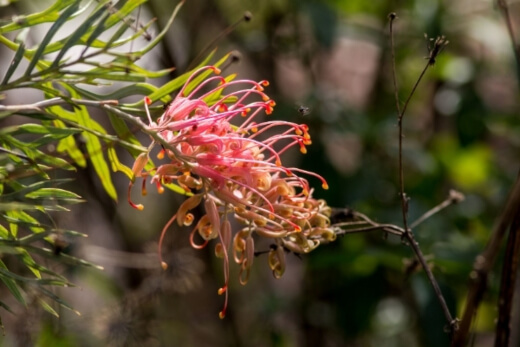
As with all plants, you need to start by selecting the right spot if you want the best results!
- Climate – As native plants, they tend to thrive in all climates across Australia. However, some varieties are more frost-tolerant than others, so be sure to check before you buy if you live in a colder area with winter frosts.
- Sunlight – These plants are sun-loving, so they require a position in full sun to semi-shade. The more shade the plant receives, the fewer flowers you’ll get, and growth may be stunted. Ideally, it should receive a half-day of sun at a minimum.
- Water – These are water-wise plants that thrive in the Australian climate, but they do need a bit of extra care in the first two years. They do best if watered regularly once or twice a week after planting (especially if it is very hot), but can manage on rainfall once they are well established.
- Soil – The soil needs to be well-draining or the roots will rot. Ideally, the soil should be loose and even sandy, with lots of well-rotted organic matter and mulch. If you have clay soil, start by mixing in plenty of gypsum, mulch and organic compost.
- Nutrients – Because it is a native plant, it requires little or no fertiliser, although a dose of a slow release low phosphorus fertiliser like a 13-2-13, a 14-0-14 or a native blend fertiliser every 2 months is recommended, especially in the first year of planting.
How to Prune Grevilleas

Grevilleas respond well to light pruning after flowering season is over, and tip pruning during the flowering season can help encourage more blooms.
If the plant is looking a bit leggy and you want dense growth (for example, for a hedge or screen), then cut back by about one-third to stimulate thick, bushy growth.
Propagating Grevilleas
The methods that work for one species do not naturally translate to another. This can be extremely frustrating or the challenge that you were looking for. Grevillea propagation is not a defined science yet and while there are ways that are proving to be successful experts are still bamboozled by this species.
At present, there are three main ways to propagate grevillea: grafting, cuttings and seed germination.
Grevillea Propagation by Grafting
Grafting has proven to be the most successful propagation technique by using Grevillea robusta as the rootstock. While this won’t work for every grevillea variety it is successful for most. Plus, G. robusta is one variety that grows well from seed propagation.
How to Propagate Grevilleas by Using Cuttings
The best way to propagate grevilleas is through cuttings, a method that has a much higher success rate than seeds. Here’s how:
- Using clean, sharp shears, take a cutting from hardened new growth of 7-10cm. This growth usually appears after the flowering season, from October to the following March. Make sure the cutting is in good condition and free of disease.
- Trim leaves off the lower end of the cutting without tearing or damaging the bark. Remove any young shoots or flowers.
- Dip into a rooting hormone.
- Plant into a low nutrient propagation soil mix. Coconut coir, vermiculite, and perlite mix should do the trick. You can also the use soil that the parent plant is growing in.
- Mist the soil to keep it moist, and keep the pot away from direct sunlight in a warm, bright room.
- New roots should appear in 4-8 weeks, and you can plant it once new growth appears about 3-4 months after that.
- Try with several cuttings at once, as this gives you the best chance of success – the extra plants make great gifts!
Germinating Grevillea Seeds
The final, but least successful form of grevillea propagation is through germinating seeds. The reason this method is not as viable is because the home gardener needs to understand how this process naturally occurs in the Australian landscape.
Seeds can often be torn apart by birds and other wildlife, eaten and then scattered by the same beasts in their droppings or invigorated by smoke in a bush fire scenario.
Just taking a seed and planting it in some potting medium will have very limited success. The seed, which is tough to collect anyhow, needs some pre-treatments if propagation is going to work.
These may include smoking the seeds until they open, heating them in the oven or microwave, soaking them in boiling water, or cutting the hard shell exterior to allow the embryo to moisten.
Once all this has been completed you may have to wait anywhere between 8 weeks and 12 months before you can determine whether your propagation has been a success or a failure.
So, while grevillea propagation may not necessarily be the best way to increase your plant stocks at home it certainly is one of the last great challenges that home gardeners have in front of them. If you have the time, and the patience, then this activity may suit you. All the best.
Common Grevillea Pests and Diseases
This is a very hardy shrub that is resistant to most pests and diseases, which is a great benefit of using native plants in your garden. The most common issue is insufficient sunlight and boggy, waterlogged soil.
On rare occasions, it may suffer from the following:
- Sooty mould – Also called blotch or black mould, this can be washed off with a weak, soapy solution, fungicide, eco-oil or neem oil.
This fungal issue is caused by mould spores feeding off the honeydew left by sap-sucking insects, so it’s important to treat any infestations of aphids or mealybugs quickly with an organic solution. - Phosphorus toxicity – These plants are very sensitive to phosphorus, and have evolved over time to use the very small, trace amounts of phosphorus in native soil.
If your fertiliser has too much phosphorus in it, it will start to burn the plant, causing yellowing on new growth and scorching on leaf edges.
Stop using that fertiliser on or anywhere near the Grevilleas plants, thoroughly soak the soil with water to leach remaining phosphorus out of the ground, and the plant should recover.
Grevilleas Frequently Asked Questions
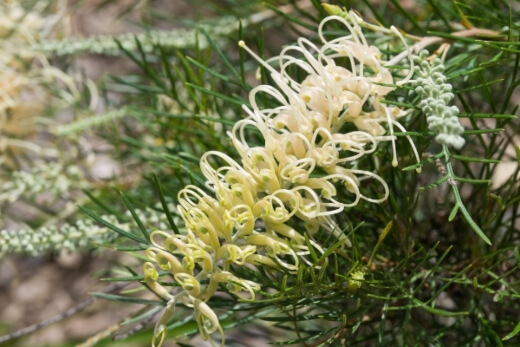
What is the best fertiliser for grevilleas?
Like other native plants, grevilleas are very sensitive to phosphorus, so it is important that whatever fertiliser you use has 2% or less phosphorus. Look for an organic 13-2-13 or 14-0-14, or ask your local nursery for a native plant fertiliser.
Do grevilleas grow fast?
Yes! They grow exceptionally quickly if they are positioned in the sunlight and supported with water and a low-phosphorus, native plant fertiliser in the first year. They are long-lived too, with many plants living 50-60 years.
There are many different varieties ranging from ground covers to screening shrubs and full trees, so check your variety first to see the full height and spread you can expect.
Do grevilleas have invasive roots?
No, these plants have a shallow root system, so they are not a threat to pipes, paving or walls. You can plant them as screening trees or shrubs without worrying that they will damage the structure with their root systems.
You should cover your bed with a good layer of mulch to keep these shallow root systems moist and healthy.
Can grevilleas be grown in pots?
Yes, but it has to be a compact variety. Be sure to look through the different cultivars and species to find one that is the right size for your container, and be sure to place your container in full sun to semi shade for the best flowers.
Use a well-draining potting soil with plenty of organic matter, feed regularly with a light dilution of low phosphorus fertiliser, and water when the top 2cm of soil is dry.
Can grevilleas grow in clay soil?
These plants generally don’t do too well in heavy clay soil, so it’s worth improving the soil before you plant. Add plenty of well-rotted organic matter, mulch and gypsum to improve the drainage, and break up dense clumps of soil to make it easier for the roots to grow.

Make Your Garden a Celebration of Native Plants with Beautiful Grevilleas!
Our team loves all plants, but indigenous Australian plants have a special place in our hearts, and Grevilleas are one of the best!
Easy to grow throughout the country, sun-loving, colourful and hardy, these plants shine in any setting, whether they’re being used as a ground cover, centrepiece, hedge, or screening shrub.
With their ability to flower for months through the winter and attract beautiful nectar-eating birds, it’s easy to see that every garden deserves its own Grevilleas!
Published on December 14, 2023 by Gary Clarke
Last Updated on September 9, 2025




